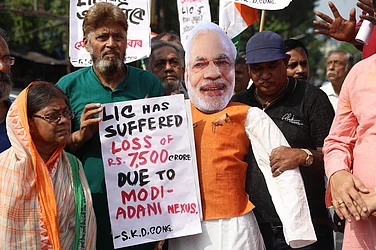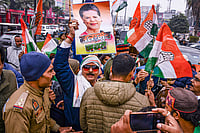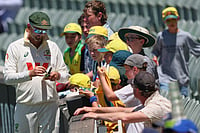Smooth skin, large breasts, an impossibly small waist, and no genitalia at all. That’s how Aparajita remembers Barbie dolls while growing up. Barbie represented everything they recall, that fit into the role that society wants women to fit into, unrealistic body type or heteronormative pairing.
Despite not coming out as queer till they were 30, Kumar who is now a sexuality educator, always found it difficult to identify with a Barbie - who wore clothing that had no cultural context. The Barbies were always either too dressed up or too scantily clad and did not fit into the imaginations of a ‘wife’ or ‘mother’ as women saw around.
“And worst of all, everyone seemed to gift me Barbies because they saw me as a girl,” Aparajita says adding, “I was supposed to play with these Barbies. At the same time, my brother got the more masculine G.I. Joes and Hot Wheels cars.” There was a total disconnect between the two siblings, who could not play together, as one was supposed to be more “feminine”, and the other games were more “aggressive.”
The Barbie Doll
Created in 1959 by Ruth Handler, co-founder and first president of Mattel Inc, Barbie was launched after an all-male toy industry rejected it saying, “We can’t sell a toy with boobs.” Only for the Barbie doll to become a cultural icon and America’s most famous doll. At a time when the only thing little girls were allowed to play with was pretend-be a mom, Barbie was sexual, womanly, had a house of her own, lived alone with a career, no husband, and no children.
Could this make Barbie the first super-mainstream feminist icon as she offered more aspirations for adult life? American singer, drag queen, and winner of “RuPaul’s Drag Race All Stars” season 3, Trixie Mattel is of the opinion that Barbie was created to be projected on. The queer readings and canons on Barbie have been a medium of rebellion by the queer community against rigid gender roles. The same is reiterated by Aparajita who underlines how the Barbie look is a popular theme in Drag.
The Gay Barbie Movies
"Somehow when you're around the sky is always blue
The way we talk
The things you say
The way you make it all ok
And how you know
All of my jokes
But you laugh anyway...
If I could wish for one thing
I take the smile that you bring
Wherever you go in this world I'll come along
Together we dream the same dream
Forever I'm here for you, you're here for me... "
The lyrics are from a 2008 Barbie movie where two "best friends" who live together sing to each other.
The Barbie universe is not restricted to dolls and toys. With almost 40 Barbie movies, horizons for queer readings and projections have increasingly expanded over the years. Although none of the Barbie movies radically impose any challenge on the patriarchal status quo and gender roles, the subtle queerness of the movie is unmissable for a queer eye.
The 2008 movie, Barbie & The Diamond Castle is often said to be the gayest Barbie movie yet. Liana, the Barbie, and her “best friend” Alexa live together in a cottage, share a room, discover heart-shaped stones, and exchange them as necklaces, make music, and even garden together. The characterization of their heterosexual partners is very weak in the movie and there is even a scene where Liana and Alexa are dragged off a rainbow, away from their cis-het partners. Released in 2017, Barbie Dolphin Magic is yet another movie on female relationships. While the villain in the movie is a woman with a pixie cut, in one scene, Isla, a mysterious girl Barbie befriends at the tropical resort “comes out” to her as a mermaid. The two later swim together as Isla teaches Barbie how to swim like a mermaid and the two seemingly have a pretty intimate relationship without any explicit sexual context. Another Barbie movie, Barbie as the Princess and the Pauper has multiple gay readings that lead to the interpretation of the queer subtext of the movie, much famous in the queer community.
A first-year psychology honours student, Ushashi shares that toys never much fascinated them, until when they first started to become conscious of their body in class six. “As I looked at my dolls one day, I realized my body could never really look like that.” Since Ushashi had a specific haircut for a very long time, a sense of belongingness struck only after they started giving them a few modifications. “I used to give my dolls a haircut that would make them look like me.”
Trans activist Rituparna Neog shares that she always saw Barbie as a gendered object which led to her disassociation with the image of the doll. Neog also highlights the economic placement of Barbie which prevented lower middle-class and lower-income families from gifting expensive dolls such as Barbies. The same is echoed by Kumar, a final-year linguistics student who says that the idea of toys and Barbie has always made him “feel poor.” Kumar’s first ever memory of Barbie was after going over to the house of his sister’s friend. He adds that representation in Barbie and other related media seems like cheating as his thoughts trail toward rainbow capitalism. He however also says that there is hope.
Rainbow capitalism and a trans-Barbie
The capitalist market is driven by the forces of cultural hegemony, which shape and dominate the assimilation of intersectional identities in terms of representation. While the representation of the queer community has gradually evolved over the years, it is the result of a long-drawn battle for acknowledgement and visibility. Often, marketing gigs and avalanches of corporate Pride collections follow the practice of tokenism as they either simply slap a rainbow sticker on already existing products to capitalise on the queer market, this is where the concept of Rainbow capitalism comes in.
However, when Mattel modelled a Barbie after the Pose fame actor and trans activist Laverne Cox in 2022, it reflected a deeper commitment to the queer community and the visibility of transwomen. The collectable Barbie broke the shackles of binaries and for the first time, young kids and adults had a queer Barbie.
As a genderfluid mother of two, Aparajita suggests that the differentiation of toys based on gender (or sex assigned at birth, to be more precise) is what needs to change, not just the toy itself. A Barbie doll, in its current avatar, could easily be gifted to a child of any gender or sexual orientation.
In a country where we are fighting to legalise gay marriage, Aparajita asks if we want to raise children who understand that toys have no gender. "What if we taught our children that there can be two Barbies who they can play 'house' with or that two Ken dolls can live together?" they say. This approach, they add would teach them inclusivity, and diversity and that there can be families where gender roles are different or even reversed. So, while a Barbie may not be the ideal toy - Mattel has miles to go. "The least we can do is ensure that they aren’t reserved only for girls or those assigned as female at birth, " says the biological mother of two


























